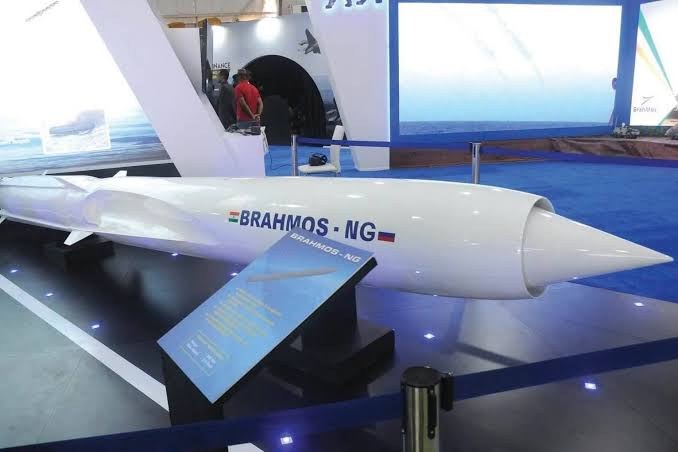In what could come as a significant boost to India’s next-generation cruise missile capability, flight testing of BrahMos-NG Indo-Russian cruise missile is expected to start before the end of 2025.
BrahMos Export Director Pravin Pathak revealed this at the ongoing World Defense Show, which ends on February 8. Pathak said, “First flight samples of the new BrahMos-NG rocket will be collected for flight tests in tandem with the plant’s development, with a target launch date of late 2025 or early 2026.”
“It is planned to collect them and start flight tests before the end of 2025,” said Pathak. He also said there were no prerequisites for non-compliance with the stated deadlines.
The announcement came when the Indo-Russian joint venture reportedly had US$7 billion worth of orders in its portfolio and was looking for potential customers in the market. “The portfolio of orders of BrahMos has already reached US$7 billion, which includes both Indian and export orders,” Pathak told reporters in a separate interaction.
India’s most capable BrahMos missile takes its name from the Brahmaputra and Moskva rivers and is developed by a joint effort between DRDO and Russia’s NPO Mashinostroyeniya. The Indian military has long used this missile, which can be fired at sea-based and surface targets from the air, sea, and sub-sea platforms.
Besides wielding the BrahMos and an extended-range version of the original missile, India remains invested in developing a stealthier and more compact version of the rocket in the wake of a perpetual China threat across the LAC.
The BrahMos Aerospace has already begun work on the BrahMos NG (Next Generation), which is expected to be a lighter and stealthier version of the existing platform.
“As one of our most lethal air-combat assets, the BrahMos supersonic missile has galvanized how we will equip ourselves with precision firepower in the coming years. Seeing the conflicts happening across the globe, the importance of precision and long-range firepower can’t be underscored,” the Indian Air Force (IAF) chief emphasized in a previous media interaction.
It was previously believed that the trials of this air-based system would begin in early 2024, which was later pushed to the fag end of the year 2024. The latest announcement, however, provides a more tangible and practical schedule for state trials.
In 2022, the CEO of BrahMos, Atul Rane, stated the new next-generation missile weighs almost half as much as the regular BrahMos missile currently operational with India. It is its most potent and lethal supersonic cruise missile. At the time, he noted that BrahMos Aerospace was set to conduct the design assessment in NPO Mashinostroyeniya in Moscow.
Military analysts have noted that the Ukraine war has played a crucial role in streamlining and pushing work on a lighter and stealthier version of the BrahMos supersonic cruise missile. The Indian Air Force understands that it needs a supersonic cruise missile that could be integrated into the smaller, lighter, and older jets to face off against a powerful navy across the Northern Border.
India’s Stealthy Brahmos To Take Another Big Leap
The BrahMos-NG (Next Generation) will be a scaled-down variant of the current BrahMos missile. Compared to the present BrahMos, it is anticipated to be 50% lighter, three meters smaller, and have the same 290-kilometer range and Mach 3.5 speed.
The current air-launched BrahMos missile weighs 2.65 tons. With the NG, its weight will decrease to 1.33 tons.
In February last year, the BrahMos CEO announced it would be integrated into the indigenously developed LCA Tejas aircraft of the IAF. With the capacity to carry long-range, beyond-visual-range missiles and short-term thermal missiles, the new BrahMos-NG, developed for LCA Tejas, would significantly increase the aircraft’s combat potential.
In the development phase, the missiles will be fitted on Russian-built jets, but later on, they will be deployed on Indian-made Light Combat Aircraft. The Su-30 MKIs can carry four NG missiles, whereas the LCA will have two. Military analysts touted the weapon integration on LCA Tejas as a game changer.

“The imperative for reducing the weight of the BrahMos NG to around 1,200 kilograms from the 3,000 kilograms of the BrahMos and the 2,500 kg of the BrahMos-A was to enable even a light fighter like the Tejas LCA Mk-1A to carry the missile,” explained Squadron Leader Vijainder K. Thakur to Sputnik News.
Because of its decreased weight and size, BrahMos-NG could be transported by a wider variety of platforms, such as fighter aircraft and conventional submarines. It can be fired from the ground, the air, the ocean, and underneath. This missile’s size allows it to be fired even from submarine torpedo tubes.
The Indian Air Force and Indian Navy’s MiG-29 fighters will eventually be equipped with the BrahMos-New Generation missile. Furthermore, if news reports from the media are accurate, they will ultimately be offered to the Russian Aerospace Forces.
With a range of up to 290 kilometers and nonstop supersonic flight, the BrahMos missile, currently used by all three wings of the Indian military, minimizes target dispersion, shortens engagement times, and ensures that no weapon system can intercept it.
Because BrahMos NG is more stealthy than the current BrahMos missile and has a smaller radar cross-section (RCS), air defense systems will find it more challenging to locate and engage the target.
The CEO stated that numerous foreign states had shown interest in purchasing different models of the supersonic cruise missile. This missile may also draw foreign buyers.
- Contact the author at sakshi.tiwari9555 (at) gmail.com
- Follow EurAsian Times on Google News




